History of Arkhangelsk
Foundation of Arkhangelsk
Arkhangelsk is one of the historical cities of Russia. In the 12th century, the Novgorodians founded the Mikhailo-Arkhangelsk (Saint Michael the Archangel) Monastery on the site of the present Arkhangelsk. This monastery at Cape Pur-Navolok was first mentioned in the chronicles in 1419.
In 1553, Richard Chancellor, an English explorer and navigator, reached the village of Nyonoksa, and then the Nikolo-Korelsky Monastery on the island of Yagra (the territory of the present city of Severodvinsk). Since that time, the Russians began to actively trade with the British and Dutch at the mouth of the Northern Dvina River.
The Mikhailo-Arkhangelsk Monastery was surrounded by numerous foreign trading posts, warehouses, barns, and huts of merchants from Kholmogory, Vologda, Moscow, who came here during the navigation season.
In 1583, in order to protect this important center of trade from a possible Swedish attack, Ivan the Terrible signed a decree ordering the construction of a fortress on Cape Pur-Navolok. In 1584, which is considered the year of foundation of Arkhangelsk, the construction of fortifications was completed and the settlement was named Novokholmogory (New Kholmogory).
More historical facts…
In 1596, this settlement was first named as the town of Archangel by the name of its monastery. In 1613, the name “Arkhangelsk” was officially approved. By the end of the 16th century, Arkhangelsk became the center of Russian foreign trade (up to 60% of the revenue of the state treasury). The growth of trade was accompanied by the development of the town. Dense groups of wooden buildings were very vulnerable to fires. In 1637, the Mikhailo-Arkhangelsk Monastery, which gave the town its name, burned down.
In the 17th century, Arkhangelsk entered its heyday, thanks to the development of trade with England and other countries of Western Europe. In the second half of the 17th century, the port became its center instead of the wooden fortress. By the end of the 17th century and in the subsequent century, Arkhangelsk continued to grow along the Northern Dvina River.
The state shipyard was built in Arkhangelsk by the order of Peter the Great in 1693. The main problem was that the port was under ice cover for about five months every year. It was one of the reasons why Peter the Great started a military campaign (the Northern War) against the Swedes in the Baltic Sea area to gain additional access to the sea. The war was successful and the town of Saint Petersburg was founded in 1704.
Arkhangelsk in the Russian Empire
With the outbreak of the Northern War (1700-1721), the White Sea became for Russia the only safe trade route to Western Europe. In 1708, the Arkhangelsk province was formed and the town of Arkhangelsk became its center. Starting from 1713, Peter the Great began to restrict trade through Arkhangelsk in order to develop the new Baltic port of Russia - St. Petersburg. The number of ships arriving in Arkhangelsk fell sharply (230 in 1715 and only 19 in 1724).
Arkhangelsk continued to be one of the main shipbuilding centers in the Russian Empire. In 1762, Catherine II lifted restrictions on foreign trade through Arkhangelsk. But the town could not regain the status of the main port of Russia. Since 1794, it was developed according to a regular plan, wide streets parallel to the embankment were built.
In 1807-1813, during the Napoleonic Wars and in connection with the continental blockade of Great Britain, Arkhangelsk experienced a new economic boom, as it was the only port in the Russian Empire where the British goods could be delivered. In 1846, a theater was opened in the town.
In 1898, Arkhangelsk was connected to Moscow by a narrow gauge railway line (through Vologda). By this time, the population of the town was about 20 thousand people. In the late 19th - early 20th centuries, Arkhangelsk became the largest timber industry and timber export center of the country. In 1914, there were 26 sawmills in the town, which employed 11 thousand workers. Arkhangelsk also was an important base for the exploration of the Arctic and the establishment of shipping along the Northern Sea Route.
During the First World War, military supplies from Western Europe and the USA were shipped to the Russian Empire via Arkhangelsk. The cargo turnover of the Arkhangelsk port grew 20 times. In 1915, under the management of the Arkhangelsk Commercial Port, an ice-breaking bureau was opened, which included 13 icebreakers. These ships provided the escort from the White Sea to Arkhangelsk during winter navigation.
In 1916, on the coast of the ice-free Kola Bay, the port town of Murmansk was founded. Over time, fish processing and ship-repair enterprises were moved there and Arkhangelsk lost its status of the main northern port of Russia.
Arkhangelsk in the 20th century and beyond
Despite the ideology of the Soviet state and religious connotations in the name of Arkhangelsk, it was not changed. Nevertheless, the Soviet period was marked by the demolition of many architectural monuments. Over a dozen churches were destroyed, including the oldest buildings in the town.
By the beginning of the 1930s, the population of Arkhangelsk increased significantly. This city continued to be the most important center for the exploration of the Arctic. During the Second World War, Arkhangelsk was one of the main ports that received cargo from the Allied countries under the Lend-Lease program (the Arctic Convoys).
In 1984, Arkhangelsk celebrated its 400th anniversary. In honor of this event, the so-called “Arkhangelsk Skyscraper” was built in the city center - a 24-story building that became the tallest building in the Arkhangelsk region (82 meters).
In the 1990s, the city experienced a severe economic crisis. The population declined by more than 50 thousand people. At the beginning of the 21st century, the first pedestrian street was opened in Arkhangelsk - Chumbarov-Luchinsky Avenue.
Today, Arkhangelsk is a relatively large transport hub and continues to play an important role as the largest center of the Russian timber industry. Also there are machine-building enterprises (specializing in the production of equipment for the forestry and woodworking industries) and shipbuilding plants.
Pictures of Arkhangelsk
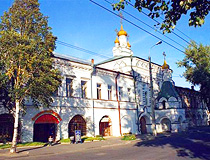
Church in Arkhangelsk
Author: Sergey Bulanov
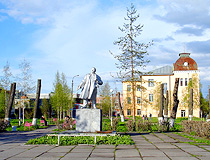
Lenin Monument in Arkhangelsk
Author: Kudinov D.M.
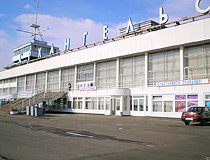
Arkhangelsk Sea-River Station
Author: Andrey Kholyavkin
Arkhangelsk - Features
Arkhangelsk is the largest city in the north of European Russia, which includes Arkhangelsk, Murmansk, Vologda oblasts, the Komi Republic, and the Karelia Republic. Since this city is located at the mouth and on both banks of the Northern Dvina River, it has a lot of bridges on its territory.
Arkhangelsk is depicted on the front side of the Russian banknote of 500 rubles - the monument to Peter I and the building of the Arkhangelsk Sea-River Station.
The coat of arms of Arkhangelsk was approved in 1780. Here is the description: “In the golden field of the shield you see the flying Archangel, who is armed with a fiery sword and shield and defeats the downed devil.” The historical coat of arms of Arkhangelsk, which had not been used in Soviet times, was restored on October 10, 1989.
The climate of Arkhangelsk is temperate, marine with long moderately cold winters and short cool summers. The average temperature in January is minus 12.7 degrees Celsius, in July - plus 16.3 degrees Celsius.
Arkhangelsk is characterized by frequent weather changes, high humidity and a large number of days with precipitation. With the invasion of cold air from Siberia, frosts of minus 30 degrees Celsius are possible in winter. At the same time, there are sometimes thaws. In summer, heat is possible up to plus 35 degrees Celsius.
The period of White Nights lasts from May 17 to July 26. During this period, in clear weather, natural light allows you to perform most types of work around the clock, including reading. Polar night and polar day are not observed in Arkhangelsk.
In Arkhangelsk there are enterprises of timber processing, fishing, microbiological, mechanical engineering, ship repair industries. The leading role in the local economy belongs to the lumber industry. These enterprises produce over 40% of the total volume of products manufactured in Arkhangelsk. Lumber, paper, cardboard, pulp, as well as fish still remain the basis of Arkhangelsk trade with other regions of Russia and countries.
This is one of the largest transport hubs in the north-west of Russia. Important railways and highways begin here, there are large sea and river ports, and two airports Arkhangelsk (Talagi) and Vaskovo. The flights to/from Moscow, Saint Petersburg, Ekaterinburg, Murmansk, Sochi, as well as some other destinations are available. The city is an important center for road transport. It is the end of the federal highway M8 “Kholmogory”. This is the only highway that connects the city with the center of Russia.
Best Sights of Arkhangelsk
Arkhangelsk is the cultural and historical capital of the Russian North. This city has a lot of preserved old buildings and museums; various exhibitions and festivals are held annually.
Tourists are attracted by the opportunity to immerse themselves in the spirit of old Russia, to get acquainted with local traditions, customs, cuisine, and crafts. The most convenient way to get to Arkhangelsk is to fly by plane (from Moscow or St. Petersburg).
If you want to see the sights of the city, it is better to go in summer. In Arkhangelsk, warm summer weather begins in late June and lasts until mid-August. In the middle-end of winter (end of February-beginning of April), there are ideal conditions for winter sports.
The most beautiful panoramas of Arkhangelsk are views of the Northern Dvina. The embankment in Arkhangelsk serves as both the main city street and the historical center. It was from here, from Cape Pur-Navolok, that the city grew along the banks of the river. Today, the installed memorial sign reminds of this.
Arkhangelsk Gostiny Dvor (The Merchant Court), built here in 1668-1684, is a complex of commercial and defensive structures, of which only one of the towers and a fragment of the wall have survived to this day. Today, it is the Arkhangelsk Museum of Local Lore. Gostiny Dvor is considered the oldest building in Arkhangelsk. Northern Dvina Embankment, 85/86.
The expositions of the Northern Maritime Museum tell about the difficult life of the Arkhangelsk sailors, who are forced to deal with severe frosts and treacherous ice. The history of navigation in the delta of the Northern Dvina began in ancient times. The exhibitions cover the period from the time when the first wooden ship was launched to the present day. Northern Dvina Embankment, 80.
Another attraction located nearby is the museum “The Old Mansion”. This house, built in 1786, was repeatedly rebuilt. Inside you can see works of art of different genres, thematic and musical evenings are held. Northern Dvina Embankment, 79.
In the very center of Arkhangelsk (Chumbarov-Luchinsky Avenue, 38), you can see one of the most interesting buildings of the city from an architectural point of view. “Marfin Dom” (“Marfa’s House”) was designed and built in the middle of the 19th century. The original building was in another part of the city and was destroyed. The present building is a copy of that house, but there are still social and cultural events taking place here.
Far from the city center to the north, on the island of Linskiy Priluk, you can see the ruins of the Novodvinsk Fortress, built on the orders of Emperor Peter I. It performed an important function protecting the city from the Swedish navy. Ivana Ryabova Street, 17.
The Building of Design Organizations (“Arkhangelsk Skyscraper”) on Lenin Square is one of the symbols of the city, which is clearly visible even from the suburbs. Built in 1984, the skyscraper remained empty for a long time. Today, its 24 floors are occupied by offices, television and radio studios.
The Art Museum of the Arctic Exploration presents unique exhibits - route maps, navigation devices, and other items used during expeditions to the Far North. You can learn more about the exploration of the Arctic by looking at the pictures of the artist A.A. Borisov, in whose honor this museum is named. Pomorskaya Street, 3.
To learn more about the culture of the Russian North, you should also go to the Museum of Fine Arts (Lenin Square, 2) and the Arkhangelsk Literary Museum (Volodarskogo Street, 10). In the first one, examples of old Russian art and folk crafts are exhibited, in the second one, you can see rare books, diaries, photographs, and other documents belonging to poets and writers, who sincerely loved the north and spent a lot of time here.
“Malye Korely” is a museum of wooden architecture and folk art of the northern regions of Russia. Located about 25 km south of the center of Arkhangelsk, this open air museum displays about 100 civil, public, and church buildings, the earliest of which date from the 16th-17th centuries.
The monument “To the Seal - the Savior of the Inhabitants of Arkhangelsk and the Besieged Leningrad” was erected in Arkhangelsk, on Northern Dvina embankment (between the streets of Karl Marx and Svobody), in 2010. During the Second World War, the meat, fat, and skins of these northern animals saved thousands of people from starvation and cold not only in Arkhangelsk and the surrounding areas, but also in Leningrad (St. Petersburg).
The captured British tank Mark V is a historical monument in Arkhangelsk installed as a symbol of the victory of the Red Army over the interventionists during the Russian Civil War in the north. Troitskiy Avenue, 104.


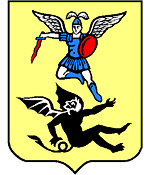
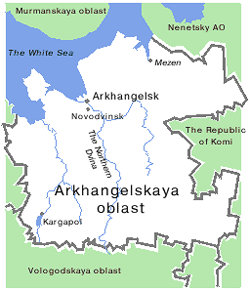



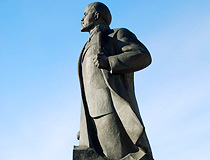
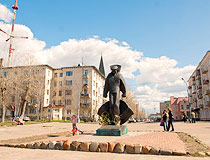
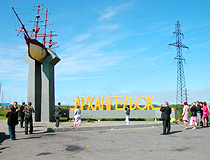
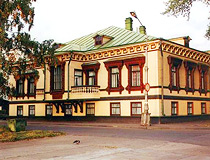
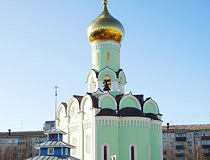
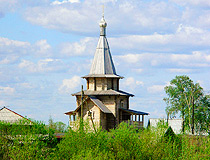
The comments of our visitors
All 7 comments